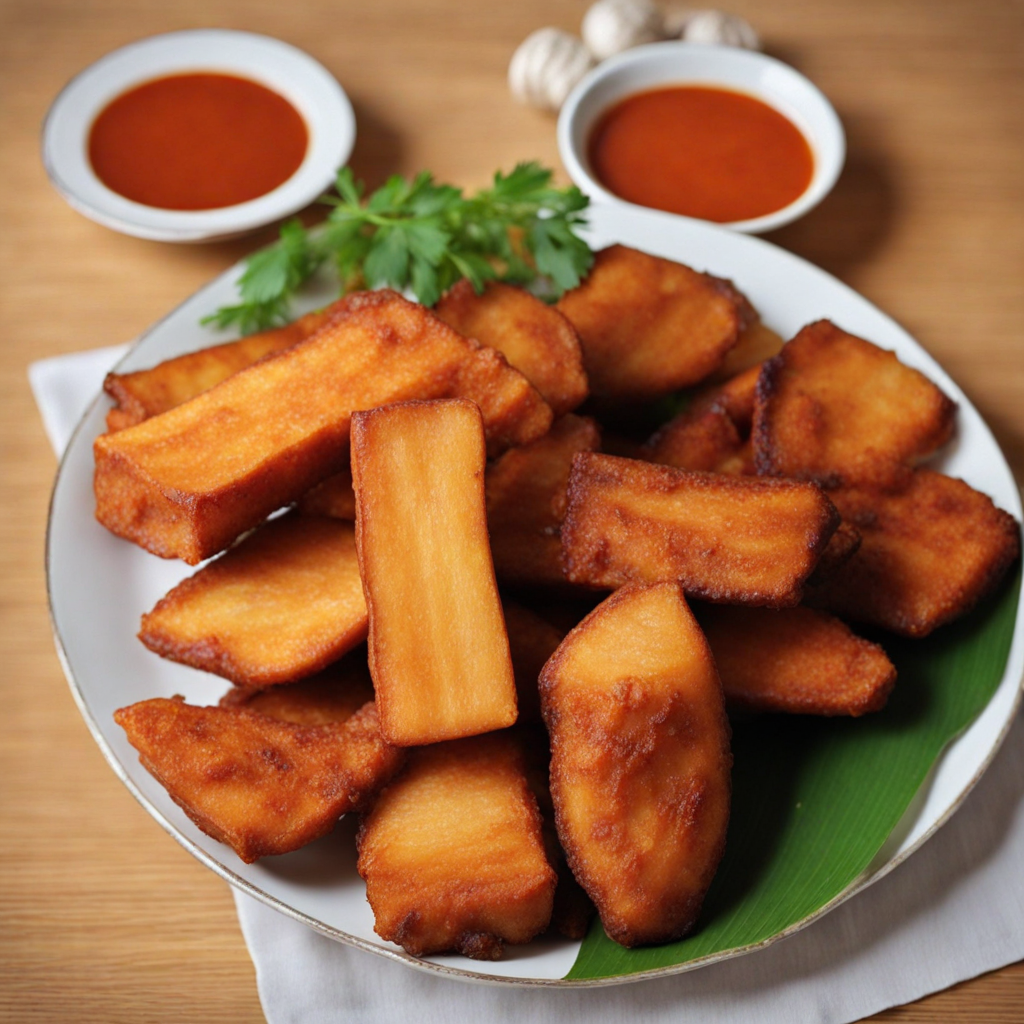Fried Yam
Fried Yam, known locally as "Chips," is a beloved street food in Ghana that showcases the country's rich culinary heritage. Made from the starchy yam tuber, this dish begins with the careful selection of fresh yams, which are then peeled and cut into thick slices or wedges. The yams are typically deep-fried in hot oil until they achieve a golden-brown color and a crispy exterior, while maintaining a soft and fluffy interior. The result is a delightful contrast in textures that makes each bite satisfying and enjoyable. In Ghana, Fried Yam is often served with a variety of dipping sauces, the most popular being a spicy pepper sauce known as "shito." This sauce, made from ground peppers, onions, and spices, adds a fiery kick that complements the natural sweetness of the yam. Alternatively, it can be enjoyed with a side of fried eggs, grilled fish, or even savory stews, making it a versatile dish that can be eaten for breakfast, lunch, or as a snack at any time of the day. The experience of indulging in Fried Yam goes beyond just taste; it is also about the vibrant atmosphere of street food culture in Ghana. Vendors often serve it hot and fresh, accompanied by the enticing aroma of frying oil and spices that fills the air. As you savor each crispy bite, you'll find yourself immersed in the lively spirit of Ghanaian cuisine, where the simple ingredients are elevated to create a dish that is both comforting and exciting, inviting you to explore more of the country's diverse flavors.
How It Became This Dish
The History of Fried Yam in Ghana #### Introduction Fried yam, a beloved staple in Ghanaian cuisine, is much more than just a simple dish; it is a culinary symbol that reflects the rich cultural heritage and agricultural practices of the Ghanaian people. With its crispy exterior and soft, fluffy interior, fried yam has become a popular street food and household favorite throughout the country. This exploration of its history will delve into the origins of yam, its cultural significance in Ghana, and its evolution over time. #### Origins of Yam Yam is a tuber that belongs to the Dioscorea genus, and it has been cultivated in West Africa for thousands of years. It is believed that yam originated in the tropical regions of Africa and Asia, with archaeological evidence suggesting that it has been grown in West Africa since at least 3000 BCE. The crop was a staple in many pre-colonial African societies, providing essential carbohydrates and nutrients. In Ghana, yam is one of the "big three" staple foods, alongside cassava and plantain. Varieties such as white yam (Dioscorea rotundata) and yellow yam (Dioscorea cayenensis) are particularly popular. The cultivation of yams is typically a communal activity, often tied to traditional farming practices. Yam is usually planted during the rainy season and harvested in the dry season, making it a vital source of food security. #### Cultural Significance Yam holds a prominent place in Ghanaian culture, symbolizing prosperity, fertility, and social status. The yam is often celebrated during traditional festivals, such as the Homowo Festival of the Ga people and the Yam Festival of the Dagbon people. During these festivities, the first yams of the harvest are offered to the ancestors, accompanied by prayers for blessings and prosperity for the coming year. In addition to its agricultural significance, yam plays an important role in social gatherings and family life. Fried yam is often served as a side dish or snack during communal meals, parties, and celebrations. It is typically paired with a variety of dips and sauces, including spicy pepper sauce, shito (a spicy pepper and fish condiment), or served alongside grilled meats. The act of sharing fried yam fosters community bonds and reinforces social ties. #### The Evolution of Fried Yam While yam has been a staple food for centuries, the method of preparing it has evolved over time. Traditionally, yam was boiled or pounded into a smooth paste known as "fufu." The introduction of frying as a cooking method brought about a new dimension to its preparation, transforming yam into the crispy, golden delicacy that is now widely enjoyed. Fried yam is made by peeling and cutting the yam into thick slices or wedges, which are then deep-fried in hot oil until they turn golden brown and crispy. The frying process enhances the flavor and texture of the yam, making it an irresistible snack. Street vendors commonly sell fried yam, often setting up stalls in busy markets or near schools, where the aroma of frying yam draws in hungry customers. The popularity of fried yam has also given rise to regional variations and culinary creativity. In some areas, cooks may add seasonings to the frying oil or serve the dish with different accompaniments, reflecting local tastes and preferences. The dish has also found its way into modern Ghanaian restaurants, where it is sometimes served as part of fusions with international cuisines. #### Global Influence and Modern Adaptations As Ghanaian cuisine has gained recognition on the global stage, fried yam has become an ambassador of Ghanaian culture in many parts of the world. Diaspora communities have introduced fried yam to foreign markets, where it is often served in African, Caribbean, or fusion restaurants. The dish has also made its way into mainstream culinary culture, with increasing interest in African cuisine. In contemporary Ghana, fried yam continues to evolve, adapting to modern dietary trends. Health-conscious consumers are exploring methods of preparing yam that reduce oil content, such as air frying or baking. Additionally, the use of local spices and ingredients has led to innovative twists on traditional fried yam, incorporating flavors from other popular dishes or international cuisines. #### Conclusion Fried yam is a delicious and culturally significant dish that embodies the history and traditions of the Ghanaian people. Its origins as a staple crop reflect the agricultural practices and communal values of West African societies. Over time, the evolution of fried yam—from its preparation to its role in social gatherings—illustrates the resilience and adaptability of Ghanaian cuisine. Today, fried yam is not only a cherished local dish but also a symbol of Ghana's culinary heritage that has crossed borders and delighted palates worldwide. As it continues to evolve, fried yam remains a testament to the rich tapestry of Ghanaian culture, celebrating the connection between food, community, and identity.
You may like
Discover local flavors from Ghana







